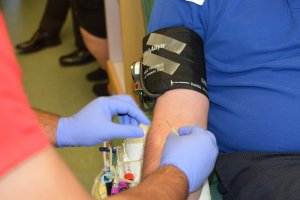What To Do After A Blood Draw
22 Oct What Causes Bruising After a Blood Draw? Preventing Bruising During Claret Donation
When information technology comes to drawing blood, at that place seems to be a never-ending list of concerns faced by phlebotomists. Tricky veins, screaming children and other not-so-fun issues tin can make drawing blood feel like a lot more of a hassle than it should be. Of course, finding meaningful employment in the medical field thank you to one'south training in phlebotomy makes these issues manageable.

Image courtesy of Pixabay.com
Of class, every phlebotomist must also exist prepared to deal with the diverse questions and concerns that are brought up by those in their care. And often, patients go concerned when bruising occurs around the area where a blood draw took place.
While patients may be somewhat alarmed at the sight of bruising after a claret draw, in most cases, this is far from unusual. ZocDoc explains that bruising generally occurs because "when a vein is accessed for a blood sample, a small portion of claret may leak into the surrounding skin as the needle is withdrawn."
ZocDoc also explains that this bruising is more than probable to occur when a large-approximate needle is used for the draw, or when a phlebotomist experiences what is frequently referred to as a "difficult stick"—when multiple pokes are attempted before the claret sample is successfully collected. The NHS notes that harm to the blood vessel or fifty-fifty a lack of practical pressure at the venipuncture site can likewise contribute to the bruising. Fifty-fifty unproblematic, everyday activities like lifting heavy objects afterwards a blood draw can put pressure on the venipuncture site and dislodge the internal clot formed.
In most cases, the bruising experienced by patients after a blood depict is nothing to exist concerned about—much like the minor pain associated with a venipuncture. However, phlebotomists can do their patients a service by explaining the importance of applying pressure level to the venipuncture site with a cotton pad after the blood describe (every bit this helps avoid bruising), and by employing another phlebotomy best practices to ensure that the entire procedure goes smoothly and is less likely to result in bruising or any other uncomfortable experience.
With time, the familiar blue-black discoloration of the bruise changes to green, then yellowish, and so information technology eventually fades and disappears. This can take up to two to 3 weeks if the bruise is large. Annotation that it is normal for bruises to spread out before fading.
The U.One thousand. National Blood Service also notes that it is common for the trample to spread or for bruising to occur "away from the donation area." This is (once over again) typically non a cause for concern, though it is recommended that patients avoid heavy lifting with the bruised arm and possibly apply pinch and water ice as needed to assist the hobbling area heal.
Prevent bruising during claret donation:
- Dress with loose-fitting sleeves are the best pick for donating blood. A tight sleeve can function merely like a tourniquet, causing congestion in the vein, and increasing the likelihood of bruising.
- Applying firm force per unit area to the venipuncture site subsequently donation until the haemorrhage has stopped will also help. Comprehend the venipuncture site with a band-aid or taped cotton wool ball that should be kept on for at least vi hours.
- Avoid lifting heavy objects for a few days after donating blood. As mentioned, this tin exacerbate any bruising. Gentle movements are recommended while the trample is healing.
- If bruising has developed, apply water ice or a cold pack to the area to help alleviate any pain or discomfort.
- Avert aspirin or ibuprofen for at least 24 hours. If you nonetheless require pain relief, acetaminophen (like Tylenol) is recommended.
Typically, the bruising volition go away after a mean solar day or 2, but in the unlikely result that the pain becomes severe, that the area begins to not bad or become inflamed or other unusual symptoms occur, it is best to contact a medical professional person immediately. All the same, such occurrences are quite rare. Every bit many a phlebotomist has already learned, blood draws are a safe and of import part of the medical process with minimal risk—even if mild bruising sometimes happens.
What To Do After A Blood Draw,
Source: https://www.phlebotomyusa.com/blog/phlebotomy-training/prevent-bruising-during-blood-donation/
Posted by: ozunaparch2000.blogspot.com


0 Response to "What To Do After A Blood Draw"
Post a Comment